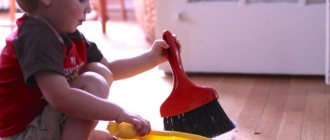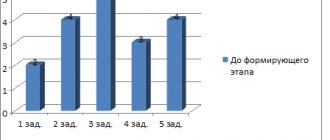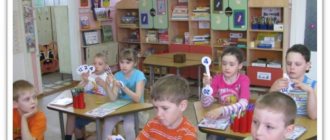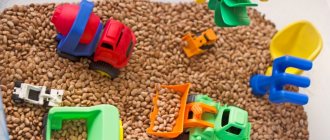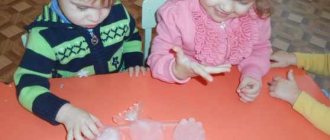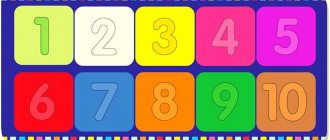Maria Montessori believed that a child's intelligence and knowledge of the world always originate in the senses. Any thought is always preceded by a process of collecting information. This means that the more subtly all the analyzers work, the more chances a person has to solve the problem facing him.
In his book “The Absorbent Mind of the Child,” M. Montessori says that sensory development allows you to open up a whole new world for the baby, making more things and their properties visible, as if someone suddenly turned on the light in a dark room.
It is important to understand that what adults consider obvious, a child has yet to learn: a small stone is lighter than a large stone, but at the same time heavier than a feather, glass is smooth and cold to the touch, and an autumn leaf is warm and rough. A child's absorbent mind is wired for learning, but it is important to place the child in the right environment where he can put his natural curiosity to use.
For more information about Maria Montessori's approach, watch our webinar for parents:
History of Sensory Education in Montessori
Maria Montessori was not the first teacher to draw attention to the importance of developing children's senses. When developing her approach, she relied heavily on the work of the French physician and teacher Edouard Seguin, who at one time worked with children with special needs and created his own system of exercises for developing children’s perceptions and teaching them everyday skills. Jean-Jacques Rousseau and Johann Heinrich Pestalozzi in their works also paid attention to the role of the development of sensory organs in children's learning.
Robert Baden-Powell, founder of the Scout movement and contemporary of Maria Montessori, said that to gain knowledge about the world, children need real experience of interacting with objects. This statement formed the basis of his theory of active learning. He highly valued Maria Montessori's pedagogical approach, noting that if teachers stop commanding and begin to more delicately reinforce a young child's natural need for new experiences, teachers can create a much more solid basis for subsequent learning and development. In his opinion, the idea of education as hard and exhausting work is hopelessly outdated.
Maria Montessori herself began her career working with special needs children who were deprived of adequate sensory stimulation: they had almost no toys, and their whole life was reduced to a series of basic caregiving activities. She was able to clearly prove that changing the living conditions of children significantly changes the level of their abilities. Today, the influence of the environment on a child’s development has been proven at the neurophysiological level. We recommend reading John Medin's book, Rules for Your Child's Brain Development, to become more familiar with this topic.
Maria Montessori created a system of sensory education based on many years of experience observing children and studying the works of outstanding teachers and doctors. Although she was not the first to discover the need for sensory experiences in child development, she was certainly the first educator who was able to draw public attention to this fact.
Sensory abilities and “competence” of the newborn
- Baby's competencies
- "Stimulation"
As the technical capabilities of psychological research improve, scientists are discovering more and more interesting facts about the sensory abilities of infants, which are called the “competence” of the infant.
In studies of the infant's competence, the active nature of his interaction with the outside world clearly emerges. The activity of the infant is manifested primarily in selective sensitivity to various stimuli: some of them are more preferred by children and are more finely differentiated, others less so. Scientists judge the degree of preference for certain stimuli in very young children who cannot speak and express their attitudes by the time they look at them and by the emotions that these stimuli evoke.
The selectivity of the child's attitude to the world has been carefully studied in experiments with visual and auditory perception, which have shown that in the first week of life, infants show unequal attitudes towards various visual stimuli. They prefer more complex, structured and brightly colored images. For example, if a baby is shown a picture of a black stripe on a white background, the child's gaze will immediately be drawn to the black outline, rather than wandering aimlessly throughout the picture. This infant preference for color contrasts helps determine the child's visual acuity. If a baby is shown two pictures at the same distance - one with bright and black lines, and the other monotonously shaded in gray, he will look longer and with greater interest at the first picture, since the contrasts formed by dark lines are more attractive to him. This is how the visual acuity of young children is determined: infants with visual impairments look at both images for the same length of time.
Similar methods have found that infants prefer complex, structured images (such as a chessboard with many squares), curved, rounded images over rectilinear ones, and closed, concentric shapes over expanded ones. Babies are especially interested in moving objects. Their gaze, as it were, “clings” to a moving object and follows its movement. Therefore, babies can look with interest and for a long time from the stroller at the leaves on trees or bushes moving above them - this “stimulation” is well suited to their innate selective preferences.
Another method of studying infants' perception is to study their orienting reactions. If a child is shown the same object or image repeatedly and for a long enough time, he gets used to it and focuses his gaze on it less and less. But if this stimulus is modified, it is revived again, and its orienting reaction is again activated. This revival of the orienting reaction may indicate that the child has noticed changes in the stimulus and that he distinguishes the new phenomenon from the original one. For example, infants are shown two red balls until they become bored with the picture and begin to turn away from it. Then they begin to be shown a red ball along with a red cube. Most infants will look at the cube longer, which may indicate that infants differentiate between the shapes of the two objects.
Using this method, domestic physiologists have shown that soon after birth a child can already perceive the timbre, volume and pitch of sounds. For example, he distinguishes between the sound of a bell and a buzzer. The repetition of the same sound caused addiction in the baby - he closed his eyes and rhythmically sucked the pacifier. But as soon as the sound was changed, the baby froze, opened his eyes and stopped sucking.
In the field of auditory perception, experimental facts have been obtained that reveal the ability of infants to localize the source of a sound: upon hearing a sound, an infant will turn its head and look for its source. But the most important fact obtained in the field of infant auditory perception is that newborn babies prefer the sounds of the human voice to all other noises and sounds. At such an early age, naturally not understanding a single word, children freeze at the sound of a voice and begin to look with their eyes for its source. It was found that young children prefer ordinary words and phrases of adults to all other sounds, even the most complex and beautiful ones (bells, string instruments, cymbals, etc.).
Thus, already in the newborn period, children are selective about environmental stimuli, preferring some of them and ignoring others. And what is especially important is that the most preferred are precisely those features that are characteristic of the image of a person (round, closed and complex shape, movement, speech sounds, etc.). The baby’s sensory organs seem to be tuned to highlight the person in the still unfamiliar external world. A child's eye is naturally predisposed to respond to a person's face, and his ear is naturally predisposed to picking up the sounds of a person's voice. It should be emphasized that among all visual stimuli, the most preferred for an infant is the image of a human face.
Rules for organizing sensory education according to Montessori
Maria Montessori noticed that at a certain age, children's behavior and motivation are very similar. For example, in the first three years a child is especially sensitive to order. This childish “pedantry” is necessary for the child to create a stable image of this world. It can also be used to develop a child’s natural need for knowledge by creating tasks that are exciting for a certain age, which would help the child master the most important qualities of objects: color, size, shape, material.
As Maria Montessori herself admitted, the work of creating the sets was not easy: it was necessary to create material that would demonstrate properties in isolation, have pedagogical value, and at the same time be attractive to the child. This is how a set of Montessori sensory material appeared.
The main objectives of Montessori sensory exercises
- Teach the baby to perceive, compare and classify sensory experiences of different modalities,
- Expand the child’s sensory experience, teach him to notice even small differences, develop the child’s senses as much as possible,
- Teach your child to use his own memory: “I remember what yellow is, and I can always imagine it in my head,”
- Teach to critically evaluate any information and develop the habit of striving for maximum accuracy when gaining knowledge about the world,
- Create a basis for the emergence of abstract thinking and imagination.
Let us explain with an example how sensory and abstract thinking are connected:
Let's say you've never seen an okapi. Now your task is to imagine this animal by description: it is a bay horse with the legs of a zebra and the head of a giraffe. Happened? If so, congratulations, your sensory development is on point, because for this exercise you need to have an understanding of the colors of horses, the coloring of a zebra and the body structure of a giraffe.
Any abstract idea is essentially a clever interweaving of various information from our real experience. That is why a child’s intelligence begins in early childhood and the ability to exercise all the senses over and over again.
What can you find in the sensory development area of the Montessori center?
Visual information
- Shapes: sets of geometric shapes, as well as more complex shapes (for example, animal figures or plant leaves)
- Volumetric figures: Pink Tower, Brown staircase, Red barbells, Montessori weight cylinders
- Colors: sets of basic colors, card index of shades
Tactile information
- Texture: palpable board, rough tablets, baskets with rags
- Temperature: heat jugs, heat plates
- Weight: weighing cylinders and plates
Stereognostics
- Sorting small items, magic bag
Audio information
- Volume: sound boxes, musical accompaniment of classes
- Height: bells, sound cylinders, musical instruments
Taste and smell
- Taste bottles, conversations during meals
- Jars with scents
In addition to exercises with isolated sensory qualities, in a Montessori space you can always find sets that combine several qualities, such as color and shape:
- Binomial cube
- Trinomial cube
- Constructive triangles
- Montessori squares
- Cylinders without handle
The study of sciences according to M. Montessori also begins with sensory education. Acquaintance with the basic qualities of objects of the natural and cultural world prepares the child for studying social sciences, biology, physics, chemistry and even mathematics:
- Sets of leaves of different plants
- Thematic puzzles
- Maps and globe
- Flags
- Sets with natural materials
- Reproductions of artists and nature photographs
What is sensory development in children
For the full upbringing of children, sensory development plays one of the most important roles. It is based on the formation of perceptions and ideas about the form and properties of objects. Sensory development plays an important role in early preschool age. It helps to create a general picture of the world around him in the baby’s head.
Beginning of sensory perception
What is this in pedagogy, definition
In pedagogy, sensory education is the development of sensations, ideas and perceptions. This is not only about introducing the baby to all the functions, but also about their targeted improvement.
Why is it so important for children
Sensory development of young children is activities that are based on the assimilation of the properties of an object. This is what underlies the development of mental abilities. Further learning depends on how correctly sensory education is structured at an early stage.
On a note! Children master and study the shapes of objects, materials, and phenomena naturally while playing, looking at pictures, or listening to music. If at this moment no help is provided from adults, then the perception will be the same as the baby’s. Most often, this leads to the fact that perception remains incomplete.
That is why it is very important that adults have control and help. It should consist of explaining the diversity of the surrounding world, replenishing the vocabulary to describe the properties of phenomena and objects.
Sensory education according to the Federal State Educational Standard should be organized in a multi-stage manner. The task of the learning process is to form certain standards in children. It is important to do everything correctly, as this is necessary for further teaching activities and children’s competent perception of new information.
It is important that the baby can not only distinguish and identify objects by their properties, but also be able to apply this knowledge to other objects. For example, the mathematical standard of shapes is the ability to identify the simplest shapes.
Mastering the properties of objects
What is the basis of sensory education?
The basis of sensory education is the joint activity of children with teachers. Game and practical situations allow you to accumulate and generalize knowledge. Practical activities include the following:
- working with a variety of materials;
- drawing with paints, crayons, pencils;
- modeling;
- reading stories and fairy tales;
- study of painting;
- design;
- motor activity.
For preschoolers, work activity plays an important role. During labor, the child develops a system of knowledge about tools, forms of labor, and methods of execution.
Construction as a means of sensory education
Sensory development tasks
The goal of sensory education for children is to enrich their sensory perception. On this basis, the following tasks are set:
- formation of various actions for examination;
- creation of sensory standards, the ability to generalize ideas about properties;
- teach children to denote objects in one word.
On a note! For each activity there must be integrity of perception and representation.
Montessori Sensory Development Ideas at Home
Despite the fact that Montessori centers use specialized kits for the development of children, it is not difficult to create a game that enriches a child’s sensory experience.
- Animal competitions. Discuss with your child how different animals move and try to organize a competition: draw a start and finish line and ask them to run sideways like a crab, hobble like a bear, or jump like a hare.
- Modeling. Kinetic sand, salt dough, plasticine and clay perfectly develop a child's tactile sensitivity. You don’t have to try to create a masterpiece right away: just learn how to roll balls, flatten them into pancakes, stretch them into sausages, squeeze them and watch how the material seeps through your fingers
- Draw with crayons on the pavement and play hopscotch. Like the previous exercise, this trains not only the senses, but also the child’s coordination.
- Game of silence. Is it just not interesting to remain silent anymore? Invite your child to remember 5 different sounds that he heard during a minute of silence (car horn, bird sounds, people talking, a dropped pencil, etc.)
- Treasure hunt. Draw a list of objects that your child should find during your next walk (a long rough pine cone, a red leaf, a yellow leaf, a dry branch, etc.). Don't forget to take a pen with you to cross out what you find.
- Drawing with stamps, fingers, brushes and even cotton swabs. It is difficult to overestimate the impact of free creative activities on a child’s development.
- Guess the smell. Place items with different scents in opaque boxes: your favorite shampoo, orange peel, a little vanilla, dried cloves, fried cutlet. Organize a competition for the keenest sense of smell.
- Experiment with musical instruments: xylophone, glucophone, kalimba, drum, tambourine, shaker, pipe. It is not necessary to immediately enroll in a music school to introduce your child to music.
- Guess the product by taste. Blindfold your child and ask him to guess what's for lunch today.
- Let your child walk barefoot more often, because there is a whole world under his feet: sand, lawn, stream, pebbles.
Sensory development of preschool children (4-5 years old)
In middle age, preschoolers begin to experience role-playing interactions in play. During play activities, children begin to realize that everything happens for the sake of the meaning of the game. This allows for the active development of visual activity. A special role is given to drawing. It becomes objective.
For example, a child at this age must realize that a person has eyes, a mouth, a nose, hair, fingers, and elements of clothing. There is an improvement in visual activities.
On a note! Children begin to draw shapes on their own, understanding their purpose, and master the skills of cutting with scissors and gluing parts. The concept of design is introduced.
The basics of sensory education for middle-aged children also include the following:
- Developing the skills to create buildings according to your own ideas.
- Development of both gross and fine motor skills.
- Particular attention is paid to the coordination of movements and dexterity of the child. He must have good balance, step over obstacles, and be able to play with the ball.
- Perception becomes more developed. Children should be able not only to recognize geometric shapes, but also to understand what objects are similar to them.
- The concepts of size, color, length and width are well developed.
- Orientation in space has been improved.
- Preschool children's memory capacity increases. They can remember eight names of objects. Voluntary memorization is formed. The child is already able to understand the task assigned to him, they remember the instructions given to them by their parents or educators.
- There is an active development of imaginative thinking. You can use schematic images to solve the problem assigned to you.
- Children can come up with a short fairy tale or story on their own. Awareness of the interaction of events develops.
- Attention becomes more stable. A child of four years old can already concentrate on one task for more than 15 minutes. When performing an action, he can remember the condition that must be met.
- Diction and pronunciation of sounds improves. Speech in children becomes more developed. At this age, speech disturbances that were previously observed may be corrected. The development of the grammatical aspect is progressing well.
- The child’s communication with adults changes significantly. It becomes more educational in nature. The child is increasingly interested in information that is difficult for him.
- From the age of 4 to 5 years, the need for respect from adults plays a major role in development. It is very important that parents and educators give praise.
Drawing lessons in the senior group on the topic “Indoor plants”
Sensory development at this age is also reflected in relationships between peers. Selectivity appears, children are divided into separate groups. Leadership begins to emerge. Competitiveness is important for the development of a child’s own image.
Important! It is necessary to direct the development of middle-aged children in the right direction. Help them form the correct idea of their image, take a position among their peers in the group!
Development in drawing
Sensory development of children aged 5 years and older
At the age of five, the most critical age begins before preparing for school. Children already clearly know the concepts of shapes, colors, and are able to compare one object with another according to their properties. They have already accumulated significant experience in tactile sensations.
The task of educators and parents is to consolidate existing knowledge. At the age of 5 to 6 years, preschoolers are already able to play intellectual games. This should be actively used in educational activities. For example, you can arrange quizzes after each topic covered.
Chess, checkers and children's lotto are great for this age. This not only trains attentiveness, but also memory and logic. It is best to focus on group games and role-playing activities from the age of five.
On a note! Activities on learning the rules of the road can be used as educational games for preschoolers. Here you can come up with both quizzes and role-playing scenes. This method will help not only to effectively consolidate new material, but also to train sensory skills.
After the age of five, special attention should be paid to the communication abilities of children. This is an important aspect of education for future schoolchildren. To do this, you often need to use group work and collective creativity. The task of educators is to help a preschooler find his place among his peers.
Games for preschoolers
conclusions
The development of a child begins with the development of his senses. In the 21st century, this is not just the opinion of teachers, but a scientifically proven fact. At an early age, it is very important for a child to learn as much as possible about the world around him using all his senses, which is why no computer can replace a child’s real experience of being in a different environment (forest, park, store, kitchen, etc.). Try to introduce your baby to a variety of objects, and think about how to organize a sensory development area for him, if the ideas of Maria Montessori are close to you.
